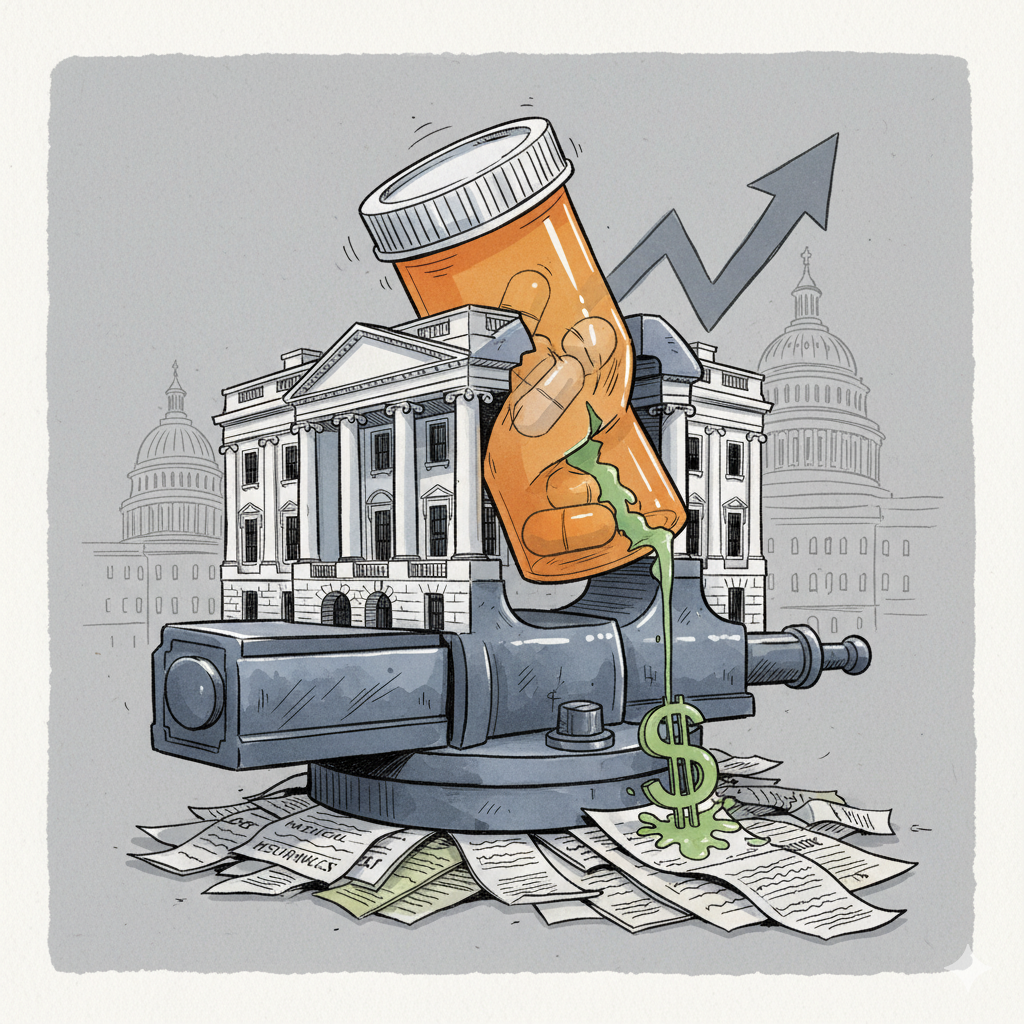The Trump-AstraZeneca Tariff Showdown and the Birth of Direct-to-Consumer Discounts

The Trump-AstraZeneca Tariff Showdown and the Birth of Direct-to-Consumer Discounts


1. Executive Summary: A Strategic Compact of Political Imperative and Commercial Pragmatism
On October 10, 2025, the Trump administration and AstraZeneca PLC announced a landmark agreement.¹ The deal aims to lower prescription drug prices for American consumers.²
This is the second agreement of its kind, following a similar pact with Pfizer Inc. in September 2025.³ It is a direct result of the administration’s aggressive “Most Favored Nation” (MFN) policy. This policy seeks to align U.S. drug prices with the lowest prices that other developed nations pay.⁴
The agreement is not a simple price reduction. It is a complex strategic maneuver, born from a convergence of political needs and commercial pragmatism.
For the Trump administration, the deal represents a tangible, high-profile victory in its war on high drug prices—a key issue for the American electorate.² For AstraZeneca, it is a calculated measure to mitigate significant risk. The company faced a credible threat from the administration of tariffs up to 100% on imported pharmaceuticals.⁵
The deal’s structure is dual-pronged. Each prong is designed to achieve distinct political and policy objectives.
The central thesis of this analysis is that the agreement’s direct impact on drug affordability for most Americans will be minimal. This includes those covered by commercial insurance or Medicare. While the deal is a significant political achievement for the Trump administration and a shrewd strategy for AstraZeneca, its tangible benefits are limited.
Multiple independent healthcare economists and policy experts support this conclusion. They note that the deal’s primary financial impact is contained within the Medicaid program. This program already benefits from substantial statutory discounts.⁸
Therefore, the deal’s true significance is not a fundamental reordering of U.S. drug pricing. Instead, it establishes a powerful new coercive framework. In this framework, the administration weaponizes trade policy to achieve healthcare policy objectives. This sets a potent precedent for all future government-industry negotiations.
On October 10, 2025, a single geopolitical announcement triggered the largest deleveraging event in the history of digital assets, exposing the fragile, overleveraged core of a euphoric market. This was not just a market crash; it was a Black Swan event that stress-tested the entire crypto ecosystem, revealing its deepest vulnerabilities and its surprising strengths.
The cryptocurrency market was shattered on Friday, October 10, 2025, by what appeared to be a singular geopolitical shock. In reality, it was the catastrophic failure of a market structure defined by extreme leverage and paradoxical sentiment. This historic deleveraging event, the largest in the history of digital assets, demonstrated the profound systemic risks that had built up beneath a surface of bullish euphoria.
President Donald Trump’s announcement of 100% tariffs on China was the undeniable catalyst. However, this report will show that the collapse resulted from a dangerous confluence of factors. The market was primed for volatility by a widely accepted “debasement trade” narrative, where a US government shutdown was ironically seen as a tailwind for asset prices. This perception led to all-time highs for Bitcoin and an unprecedented buildup of speculative, leveraged long positions.
The tariff announcement acted as a pinprick to this overleveraged bubble, triggering a violent liquidation cascade that erased between $9.5 billion and $19 billion from derivatives markets in 24 hours.¹³, ¹⁹ On-chain analysis reveals that the decentralized derivatives exchange Hyperliquid was the primary venue for this deleveraging.¹³ Furthermore, forensic evidence points to the strategic actions of sophisticated whale traders who not only anticipated the market’s vulnerability but also positioned themselves to profit immensely from the chaos.², ¹² This suggests the event was both a market-wide panic and a predatory hunt.
The analysis concludes with an assessment of the market’s structural health in the aftermath, identifying key indicators that will define its trajectory and offering a forward-looking perspective for navigating the new paradigm.
(more…)Executive Summary: The Race to Succeed Trump
As of October 2025, President Donald J. Trump is nearly one year into his second, non-consecutive term. The Republican Party is entering a period of profound transition. President Trump is constitutionally barred from seeking a third term. His impending departure from the political stage in 2029 has set in motion an “invisible primary” for the 2028 Republican presidential nomination.1
This contest is the first truly open Republican primary in twelve years. It is already taking shape not in formal announcements, but in the strategic positioning of ambitious figures. These contenders are found within the administration, across the nation’s statehouses, and in the halls of Congress. The race to succeed Trump began, in many respects, the moment he secured the 2024 nomination.3
A clear heir apparent dominates the emerging field: Vice President JD Vance. His position as the president’s deputy establishes him as the undisputed frontrunner.3 This standing is reinforced by his ideological alignment with the populist base and a commanding lead in early polling. His candidacy casts a long shadow over the entire field. It creates a gravitational pull that forces every other potential contender to define themselves in relation to him.
The central dynamic of the 2028 primary will be whether any challenger can mount a credible campaign against the sitting Vice President. He is widely seen as the ideal successor to carry forward the Trumpian political legacy.1
Beyond the Vice President, the field of potential candidates is vast. It can be categorized into distinct tiers of contention, each with its own strategic imperatives. This report organizes the 100 most likely contenders into a six-tier framework:
The primary contest will be fought across several emerging ideological lanes within the party. The dominant lane is the MAGA/Populist movement, which demands unwavering loyalty to President Trump’s agenda. A second, diminished but still relevant, lane is the Establishment/Business wing, which seeks a more traditional, pro-business conservative leader. A third, and most tenuous, is the remnant Moderate/Anti-Trump faction, searching for a standard-bearer to move the party in a new direction. The success of any given candidate will depend on their ability to navigate this complex and often contradictory ideological landscape.
(more…)Introduction: Two Paradigms of American Capitalism
This report conducts a deep comparative analysis of two titans of American business: Donald Trump and Marc Benioff. They represent divergent yet potentially converging models of power and influence.
Donald Trump is the master of the brand-as-asset. His empire is built on the symbolic, monetized value of his name. He cultivated this brand through decades of real estate development and media saturation.¹ His philosophy is one of combative transactionalism. He views the world as a zero-sum arena of winners and losers.²
In contrast, Marc Benioff emerged as the champion of the platform-as-ecosystem. He built his empire on the functional indispensability of his enterprise software.³ He also publicly espoused a philosophy of “Stakeholder Capitalism,” which posits that business should serve the interests of society at large.⁴
This analysis is not a static comparison. It is an examination of a dynamic and strategically significant shift.
This report’s central argument is that corporate ideology is ultimately subordinate to pragmatic business imperatives and political expediency. This holds true even when an ideology has been meticulously cultivated over decades.
Marc Benioff’s recent actions demonstrate this principle. His progressive persona has apparently dissolved. This is marked by his endorsement of Donald Trump and his adoption of authoritarian “law-and-order” stances.⁵
This shift reveals the transactional nature of political alliances in modern American business. It also exposes the potential fragility of “Stakeholder Capitalism” as a core principle. The philosophy can function as a strategic posture, abandoned when it conflicts with the primacy of shareholder value in a volatile era.
This section provides a detailed, comparative analysis of the business models of the Trump Organization and Salesforce. It traces their evolution from inception to their current state.
The two empires reveal fundamentally different approaches to capital, risk, and the nature of a modern business enterprise. One is built on tangible assets and symbolic value. The other is built on intangible code and functional utility.
The following timeline highlights key milestones in the careers of Donald Trump and Marc Benioff. This helps contextualize the development of their respective empires.
| Year | Donald Trump | Marc Benioff / Salesforce |
| 1968 | Begins career at his father’s real estate company.⁶ | |
| 1971 | Takes control of the family business, renaming it the Trump Organization.⁷ | |
| 1978 | Orchestrates first major Manhattan deal with the Grand Hyatt Hotel.⁶ | |
| 1983 | Completes construction of the iconic Trump Tower.⁸ | |
| 1986 | Joins Oracle Corporation after graduating from USC.⁹ | |
| 1987 | Publishes The Art of the Deal.⁸ | |
| 1990 | Opens the $1.1 billion Trump Taj Mahal casino in Atlantic City.⁶ | Becomes Oracle’s youngest-ever Vice President.⁹ |
| 1991 | First of six business bankruptcies begins with the Trump Taj Mahal.¹⁰ | |
| 1999 | Founds Salesforce in a San Francisco apartment.¹¹ | |
| 2004 | The Apprentice reality TV show debuts, boosting his brand’s value.¹ | Salesforce goes public, raising $110 million.¹² |
| 2009 | Salesforce reaches $1 billion in annual revenue.¹² | |
| 2020 | Salesforce acquires Slack for $27.7 billion.¹¹ | |
| 2024 | Salesforce introduces Agentforce, its enterprise AI platform.¹³ |
Dec 22, 2016
Obama Administration Scraps Post-9/11 Immigrant Registry: In a move to preemptively block its use by the incoming administration, President Barack Obama’s administration officially dismantled the regulatory framework for the National Security Entry-Exit Registration System (NSEERS). The program, which had been dormant since 2011, had required registration and tracking of male immigrants from predominantly Muslim countries.
https://en.wikipedia.org/wiki/National_Security_Entry-Exit_Registration_System
The most insidious threat is the normalization of the political ideology that fuels terrorist groups: Islam. While TX Gov. Abbott is fighting back, recently reaffirming the state’s ban on Sharia law, the White House is moving in the opposite direction. It is actively promoting Sharia as a legitimate financial system. Hidden in plain sight on the White House’s own website, among glowing press releases about “trillions in great deals,” is a statement from Franklin Templeton’s CEO, Jenny Johnson. She praises the Trump administration’s policies for helping her company, a global asset manager, grow “leadership in global Sukuk and Sharia compliant investing.” Let that sink in. The Trump White House is celebrating, as a key economic victory, the expansion of a financial system based on religious laws that are fundamentally hostile to American liberty and Constitutional principles. It is a full endorsement of the financial arm of a political ideology we should be fighting, not funding.